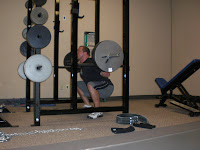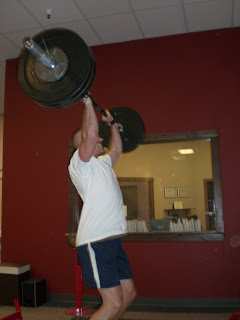What is Functional Training?? Functional Training has been a "buzzword" in Fitness for the last 10-15 years. It has been defined as, "The total chain operating together to initiate movement in several planes of motion". Speed, Reaction,
Proprioception, Multi-Plane, Multi Directional, Adaptability, Efficiency, Stability, Endurance and Skill have all been associated by many in the fitness community to coincide with Function, and I conditionally agree with this. That being said, two very important components of Functional training that are often overlooked and brushed aside by many are Strength and all the facets of strength as well as Power. They too should be included in the definition of Functional Training as well and it is very unfortunate that some ignore the importance of these essential components of functional training.
Many in the "Endurance" Arena, Runners and Cyclists to name a few, often fail to incorporate an appropriate level of "True" Strength Training into their training routines. Failure to do this can and does typically lead to overuse as well as "impact" injuries that can be seen in many runners and additionally does not enable one to attain an optimal level of performance. Doing hi rep low weight leg curls, leg extensions as well as calf raises and even leg presses does little to enhance ones Functional Strength. Moreover, Relative Strength which is probably one of the most important facets of strength that can minimize injury as well as increase exercise performance, especially for Endurance Athletes is frequently overlooked. Ask a runner what he or she does to enhance their Relative Strength and it is likely that they don't even know what it is. But yes they do balance work on a soft forgiving surface....
There are some who promote injury prevention that get "up in Arms" about Squatting below parallel, yet few point the finger at how damaging running/jogging itself can be for the body, up to 6 times or more of one's body weight can be impacted upon foot strike with the ground when running, especially downhill. Not to mention, many of the Isolated Leg Extension Machines seen in most commercial gyms have a seat angle that places the knee beyond a 90 degree angle, and if any instance where a angle greater than 90 degrees of knee
flexion is potentially harmful, this would be it!
In addition, because the Hip and Knee joints are only partially flexed when jogging much more force is transferred directly through the knee joint itself. This leads me to what I call "The Spontaneous Combustion Principle", this is when the Knee Joint suddenly bursts into smoke & dust as one squats below 90 degrees at the knee joint (this is fictional and really does not occur but according to some it very well could...). In reality, in the world of physics, it would be far less of an exaggeration to say that if a runner cannot squat at least his or her own body weight to parallel and if a runner cannot perform at least 5-10 Single Leg Squats each leg that he or she has no business running a 5k, 10k or marathon. If you weigh 125lbs as a female and you run 5 to 10 miles a couple days per week don't you think your knees and other joints would appreciate it if you trained your body to better absorb and dissipate the forces that impact your joints when running? If you do the math that is a great amount of pounding on the joints if one is not as strong pound for pound as they can be.
More importantly, if ALL you do is Jog to stay in shape or for recreation there is a good chance that you are shortening your quad muscles which typically will lead to
patellar tendinitis, or other types of overuse injuries, such as plantar
fasciitis. I have trained so many runners who run run run, but ask them to do a Single Leg Squat to at least 90 degrees at the knee, and they crumble, lose balance, and basically "plop" right onto the bench or step or box behind them. Yet these people think that they are
ok to go out and run run run, several days per week, mile after mile absorbing impact through ankle, knee, and hip joints with forces several times their body weight.
True Functional Strength training can help improve performance and reduce risk of injury regardless of your sport or activity. There are 4 main components of Strength that exist, they are: Absolute Strength, Explosive Strength, Starting Strength, and Reactive Strength. However, Relative strength (how strong a person is pound for pound) should very much be included as an essential component of strength. How important each of the components of strength are to a given athlete depends entirely on the demands of his or her activities that they may encounter in their job, sport, everyday life, or recreational activity. That being said, there are some current trends in Fitness that claim to be Functional Training but in reality are simply Rehabilitation exercises that have somehow been included in the definition of what Functional Training is, and this is unfortunate because it is a "stretch" to say the least. I have no issues with Rehab and/or Corrective Exercises but they should remain as such and not be linked to Functional Training.
For instance, many people assume that the
BOSU Ball is some sort of God sent training apparatus that HAS to be included in peoples fitness routines because it has been touted as a way to work your "core", improve balance,
proprioception, and thereby reduce the risk of injuries. Unfortunately, this is not entirely true and it really is more like a wolf in
sheep's clothing if misused. This method as well as other similar methods of rehab have been brought into the fitness community by people preaching injury prevention, etc. An Overhead Squat, Goblet Squat, and
Deadlift work your "core" to a MUCH greater extent than any
BOSU Balance or "core" exercise, and they all have a greater functional carryover to performance enhancement.
In reality, if you are a healthy injury free runner and/or even a Power Athlete, such as a football player, using the
BOSU to train for core & balance can actually "
de-train" the Stretch Reflex Mechanism, which is extremely important for explosive muscle action as well as a force reduction. If you
de-train the Stretch Reflex Mechanism you actually are reducing how explosive you are, as well as how well you can reduce force, which in no way would be of benefit. Going from training on a cushioned, buffered surface that yields to ground reaction forces compared to running on pavement, trails or playing on basketball and tennis courts, etc. is a sure fired way to actually increase your chances of injury. The contrast in surface hardness' are drastically different in terms of shock absorption and therefore the specificity of training principle holds true here. Typically when one sprains an ankle or tears an
ACL it was not due to the ground being soft, squishy and bouncy, in fact the ground or surface is typically rigid and thus not cause or mechanism of injury. Yes playing Soccer on a field that is very uneven and has many
divots can definitely cause an ankle or knee injury, but just because you train for balance on a
BOSU it probably won't prevent an injury from
occurring.
Although it goes without saying that there are certain times in ones training cycle when it is appropriate to "
deload" (in terms of intensity, force, impact, etc.) thereby allowing the body's recovery abilities to super compensate and thereby ensure peak performance and recovery to the imposed demands. The problem, however, is when the fitness professional incorporates this type of training frequently (if not daily) with otherwise healthy people. Yes the
BOSU can be a fun way to change things up a bit provided you don't fall off getting on or off of it. There is no graceful way to fall off of a
BOSU!
Balance training on the
BOSU, as well as Half Foam Rollers, Dyna Discs, etc. do have a place in rehab but, their importation into the realm of fitness has been grossly over emphasized and it's promotion as a fitness tool has somewhat misled many into thinking they are less susceptible to injury when in fact the opposite is entirely feasible. If you are rehabbing from an
ACL injury, somewhere in the rehab program the Physical Therapist will reintroduce
plyometric type exercises into the program. INITIALLY it would be appropriate for a patient to use the
BOSU or other types of springy trampoline like training tools to help dampen the severity of impact on the newly reconstructed joint. ULTIMATELY though, a progression towards higher intensity
plyometric exercises to specifically train the Stretch reflex mechanism without the use of these (buffers) tools would be in the patients best interest as they make their way back to full function as far as performance and restrictions go. These "balance" and "core" tools are better left in the Rehab world as that is where they truly have a purpose.
Functional Training, as touted and promoted by many in the Fitness community, really can be more dysfunctional than it is functional, simply from the principle of specificity. If the surface one typically ran on is hard and the surface he or she performs
plyos or "balance" training on is too forgiving ,then how can any benefit be carried over to the desired activity of running? The same can be said for those who think of Strength Training for runners as being a set or 2 of calf raises, leg ext and leg curls followed by some
triceps kickbacks. Runners should be able to do Single Leg Squats well, and be able to squat his or her body weight to at LEAST parallel in order for their training to be considered functional. Many people who shun True Strength training are simply just not very good at displaying or exhibiting it in the first place. So they stick to what they are good at, and not what they NEED to be good at. The bottom line is that EVERY athlete needs some form of strength (as outlined above) to be able to compete at an optimal level, reduce risk of injury and be as functional as they can be.


 In these photos: 1. Tucker, Kids CrossFit Challenge 2. Tony Deleo, Strongman Challenge, Tire Flip 3. Tony Deleo, Tire battle wounds.
In these photos: 1. Tucker, Kids CrossFit Challenge 2. Tony Deleo, Strongman Challenge, Tire Flip 3. Tony Deleo, Tire battle wounds.






















.JPG)




